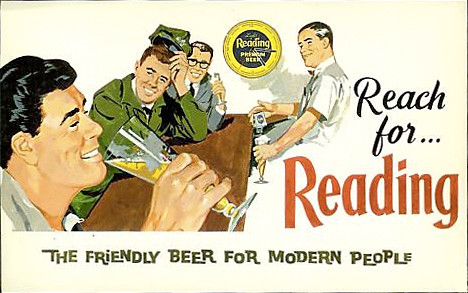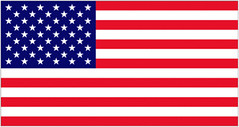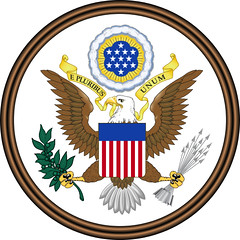
Today’s infographic is The United States of Good Beer, created by Good, with one brewery per state.

Click here to see the map full size.
By Jay Brooks

Today’s infographic is The United States of Good Beer, created by Good, with one brewery per state.

Click here to see the map full size.
By Jay Brooks
![]()
Today’s infographic is a map of breweries in the United States, though from when exactly I’m not quite sure. It was created by Pop Chart Labs and is version 1.1.

Click here to see the map full size.
By Jay Brooks

Today’s infographic features a map of the 13 original colonies and the historic breweries located in each of them.
Click here to see the map full size.
By Jay Brooks

Friday’s ad is from the early 1930s, for Pabst Blue Ribbon, though it references the NRA — not that one, the other one — in this case the National Recovery Administration. The NRA was the agency charged with implementing the National Industrial Recovery Act, passed in June of 1933, as part of the New Deal effort to combat the Great Depression. Since it was found unconstitutional by the Supreme Court in 1935, there’s a pretty short window when the ad most likely ran. Still, the illustration is pretty cool, and looks like the later Beer Belongs ads that the industry ran after World War 2.

By Jay Brooks

The Brewers Association just released the number of breweries in the U.S. as of the end of last year. As of December 31, 2012, there were 2,336, which represents an increase of 387 over the previous year, meaning just over one new brewery opened every single day. Just as staggering; the total number of breweries-in-planning stood at 1,254.
And here’s the breakdown:
By Jay Brooks

Today’s infographic is courtesy of Travel Insurance, and is entitled A Beer Tour of America. It’s geared toward the big boys and a few of the larger regionals, but if you were shopping for travel insurance, this would still be a far better way to spend your time.

You can see the chart full size at Travel Insurance.
By Jay Brooks

Canada’s Random House Publishing runs an interesting website called Hazlitt, where, presumably, they feature their own authors on a variety of topics. The one that caught my attention was by Linda Besner, and it’s an essay about My Best Friend, beer.
She begins by claiming that mankind has been “thinking and talking about beer since 4000 B.C.” She’s only off by as much 5,500 years, since brewing is believed to have begun with the “advent of agriculture in the Neolithic Period of the Stone Age about 11,500 years ago.” I don’t want to dwell on that, because we haven’t even gotten to the meat of it, but it did make me initially skeptical.
The story concerns a study that examined beer commercials from both the U.S. and the Ukraine, described as a “cross-cultural study of beer’s metaphors.” Again, I’m quibbling a bit, because the researchers looked at a total of 37 ads from both nations, not exactly a large number, but the author credits them with having “seen a lot of beer commercials.” I think the average consumer might see nearly that many during the average football game, or certainly over the course of a Sunday watching sports in general. But okay, let’s let them make their point. What did they find?
“While the personification of beer is consistent from Ukrainian to U.S. commercials, it seems to me that the kind of person beer is in Ukraine is different from the kind of person beer is in the States.”
In the Ukrainian commercials, the study notes, “people do not become friends by sharing beer; rather beer drinking occurs among individuals who are already established as friends, which entails a close and trusting relationship.” The people drinking beer together are described as druh, which Dr. Lantolf translates as being like the English concept of “best friend,” rather than tovarysch, which translates as “comrade” or “acquaintance.”
In the United States, it’s almost the opposite. Apparently, we use the term “friend” rather loosely, calling people we hardly know, or have just met, our friends. In other words, many of our friends are more superficial, at least compared to how Ukrainians see them.
To illustrate, they give the example of a Budweiser commercial currently up on YouTube under the name “Magic Beer.” A young man sits alone at a bar, opening a bottle. He pours it into his glass, but, miraculously, once the glass is full, beer continues to spill forth. Quickly, he pours some of the excess beer into the glasses of the men next to him. In the next shot, the bar is packed with carousers dancing to a live Scottish band as beer continues to gush from the magic bottle. The erstwhile lonely young man dances between his new friends, a beatific look on his face. Then he drops the bottle. It smashes on the floor, and the flow of beer trickles to nothing amid ghastly silence. The outraged people around him glare daggers. Those closest to him turn and walk away.
Frankly, I hate these ads. They’re not just superficial, they’re utterly ridiculous. Saying they’re depicting how typical Americans act, or view friendship, seems like quite a leap. I think it says more about the advertisers than the consumers, and maybe even a little about the researchers that they think idealized commercials reflect real life.
Even if I accept the premise, that that may be how some people see their “friends,” I’ve never considered such people my friends. Fair-weather friends, perhaps, but that’s a rather derogatory expression. Is it possible I’m not typical? No, I don’t think so, because I’m pretty sure most of the people I know well feel roughly the same way.
I love beer. I make my living writing about it, reviewing, analyzing it, along with the people and companies who make, sell and market it. I have admittedly made friends, to varying degrees, with actual people who work in the industry. But I’d never mistake the beer itself as my friend. It’s an inanimate object, after all. I may love beer, but in the same way I love potato chips or frites. It’s not the same as another person. Doesn’t everyone know the difference?

Not according to the study, apparently. To wit:
It seems that not only do Americans see beer as a person, they see beer as a person other people like better than them. In this scenario, beer is the cool friend you bring to the party who makes you popular by association. As soon as your cool friend leaves, no one wants to hang out with you anymore. It’s doubtful, Dr. Lantolf says, that the producers of “Magic Beer” and other commercials are consciously depicting shallow friendships: “I think that what they were showing is how Americans typically behave.: Dr. Bobrova is originally from the Ukraine, and she says, “I didn’t expect that American commercials would show this superficial concept of American friendships. I have many friends in the U.S. and we spend time together and I share everything with them as with Ukrainian friends. But commercials show a little bit of a different picture. But then,” she adds, “I’m not a beer person.”
Should I be insulted by that? I’m really not sure. I don’t believe that’s “how Americans typically behave.” Sure, there are certainly superficial people in the world, and I’d be willing to accept that a lot of them live here in the States, but I don’t think it’s something most people aspire too. I don’t think Americans view superficiality as a positive attribute. So when the researchers say they think “Americans see beer as a person,” it’s the people in the commercials who may “see beer as a person,” but they’re not real. They’re actors. It’s not the same thing. The advertisers are projecting an image onto the characters to sell us something. It’s not necessarily a reflection of real people, or real life. Am I off base here?
I know many Canadians quietly don’t think too much of their neighbors, and there are certainly times when I agree with them, at least about how we sometimes behave and view the world. But this one I just don’t quite understand. The author of the piece, Linda Besner, is a poet from Quebec who recently published her first collection, The Id Kid. And they may be fine poems, “sassy and sumptuous,” as her publisher describes them, but I can’t help but think she doesn’t know human nature as well as she might think. But the researchers have even more to answer for, since they’re from the University of Pennsylvania, the same school where Patrick McGovern, author of Uncorking the Past, does his research and teaches.
In the end, however effective advertising can be, I tend to think most people know the difference between it and real life. My old hometown beer — Reading Premium Beer — used to advertise with the wonderful slogan: “The Friendly Beer for Modern People.” I love that phrase, but it’s utterly meaningless. I don’t think beer can be friendly, any more than my cat actually likes me when I rub her belly. Oh, sure, it looks likes she’s smiling, but I know she really thinks of me as the hired help. But actual personification, or anthropomorphisation in the case of my feline companions, of beer is ultimately just as futile. It’s just the advertisers trying to project — maybe that needs a new word: advermorphisation — human characteristics onto inanimate objects. Beer will never be my BFF. The people I drink beer with? Those are my people, my true BFFs.

By Jay Brooks

Here’s an interesting little snapshot of the various containers beer comes in over the last thirty years from the Container Recycling Institute. In Container Types Used For Beer in the U.S., 1981-2010 , they detail how beer in bottles have increased steadily 15% over that time and now make up almost 40% of how beer is sold. At the same time, draft beer has receded. Cans are still on top, but dipped significantly beginning in the 1990s, but in recent years have started to rebound.

By Jay Brooks
![]()
Today in 1776, the United States declared their Independence from Great Britain.
United States

United States Breweries
Last year I did a page of brewery links for each state, which can be found below:
United States Brewery Guides
Other Guides
Guilds: Brewers Association; Beer Institute, numerous State Guilds plus many additional U.S. organizations
National Regulatory Agency: TTB
Beverage Alcohol Labeling Requirements: TTB Requirements
Drunk Driving Laws: BAC 0.08%




Alcohol Consumption By Type:
Alcohol Consumption Per Capita (in litres):
WHO Alcohol Data:
Patterns of Drinking Score: 2
Prohibition: 1920-1933

By Jay Brooks
![]()
This is my sixth annual annotated list of the Top 50 so you can see who moved up and down, who was new to the list and who dropped off. So here is this year’s list again annotated with how they changed compared to last year.
Some new companies made the list, one from a merger — Gordon Biersch and Rock Bottom — now CraftWorks Breweries & Restaurants, along with Bear Republic, Blue Point, Lost Coast (which had been on the list two years ago), Narragansett and Ninkasi.
Off the list was Straub, Independent Brewers United (IBU), which was swallowed up by North American Breweries, Kona Brewing, which was folded into the Craft Brewers Alliance, and individually Gordon Biersch and Rock Bottom were combined into CraftWorks Breweries & Restaurants.
If you want to see the previous annotated lists for comparison, here is 2010, 2009, 2008, 2007 and 2006.
